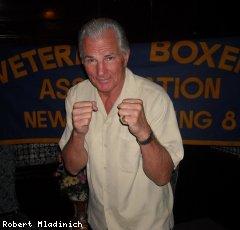Memories With Mladinich: Bobby Bartels
 Back in the mid-1950’s the scourge of heroin had reared its ugly head in working class sections of New York like Astoria, Queens. Other social changes were occurring as well.
Back in the mid-1950’s the scourge of heroin had reared its ugly head in working class sections of New York like Astoria, Queens. Other social changes were occurring as well.
Rival gangs, which were usually determined by ethnic origin, were battling for control of their turf. Tensions that would now be considered racial in nature were at the time thought of as nothing more than neighborhood rivalries that sometimes turned violent.
“It seemed like everyone was doing junk (heroin) in those days,” said Bartels. “It was very easy to get into trouble. A lot of my friends wound up dead from that crap.”
Bartels’ family had a fierce work ethic, as well as a rich boxing history. “My grandfather, Charley Bartels, owned an ice business in downtown New York (Manhattan),” said Bartels. “He dabbled in boxing. He was a timekeeper at the old Broadway Arena, and he was involved in other ways, too.”
At the age of 17 Bartels began boxing with his good friend Henry Wallitsch, who is the current president of Ring 8, Veteran Boxers Association in New York. Both would go on to become legitimate working class heroes as professional fighters.
“Being a boxer in those days, you were made to feel special because there was so much crap going on,” said Bartels.
Before long Bartels was training at the fabled Stillman’s Gym in Manhattan. It was there that he got some of the most valuable lessons of his life.
“It was a fabulous gym,” he recalled. “Guys like Joey Giardello, Dick Tiger and Ike Chestnut trained there, and they all treated me so good. Everyone got along great: blacks, whites, Italians, Irish. Everyone!”
As exciting of a boxer that Bartels was, his movie star looks gave him an even larger fan base. He began his career with two first round knockouts at the St. Nicholas Arena in June 1958.
In his third bout, he battled Felix Machado, a veteran of 20 fights, at Madison Square Garden and won a four round decision.
“My father sold a lot of tickets,” said Bartels, who between 1958 and 1966 amassed an 18-8-1 (8 KOS) record against some pretty formidable competition.
“I fought a lot at the Garden, which was very special to me,” said the 69-year-old Bartels, who appears to be in his mid-forties.
“Once I started fighting main events, every time I would hear the national anthem before my fight I’d get chills. It’s funny how different things affect you. I remember listening to the anthem more than the fight itself.”
Bartels, who had once battled imaginary rivals on the streets, now found himself fighting ring rivals who hailed from other areas of New York’s five boroughs. In December 1959, he lost a split decision to Jimmy Archer of Manhattan’s Upper East Side at the Academy of Music.
“We were wrestling around, I tripped, and the ref called it a knockdown,” said Bartels. “I was so mad, I pulled my mouthpiece out and was arguing with the referee. That one point for the knockdown cost me the fight.”
A December 1964 fight against Lenny Mangiapane at MSG was memorable in more ways than one. A crowd of about 5,000 fans were in attendance. An equal amount of fans were from Corona, Queens, the Italian enclave where Mangiapane hailed from, and Astoria, which was more of an ethnic hodgepodge.
“Back then if guys from Astoria met guys from Corona at a dance or a bar, there was trouble,” said Bartels. “So you can imagine what it was like when we were in the ring.”
Bartels stopped Mangiapane in the fourth round and a riot ensued.
“When Lenny got up from a knockdown, he stepped out of the ring,” explained Bartels. “He had one foot out of the ring, and one foot in the ring.”
Mangiapane’s manager contended that his fighter was trying to kick a photographer who was distracting him by his improper use of flashbulbs.
Mangiapane will tell his version of those events in an upcoming TSS feature.
Regardless, both ex-fighters are now good friends who have each served on the executive board of Ring 8 for what seems like eons.
In 1964 Bartels and Wallitsch traveled to St. Louis, where Wallitsch took on the much taller future heavyweight titlist Ernie Terrell. Although Bartels stopped the unheralded Rufus Mack in four rounds, the fight was extremely memorable for him because it was refereed by former heavyweight champion Joe Louis.
“I couldn’t believe it,” said Bartels. “I was honored to be in the same ring with Joe. He was a phenomenal fighter and a great person.”
Bartels also lost a tough fight to Billy Collins, whose son Billy Jr. was a participant in the notorious 1983 fight with Luis Resto. Resto has since admitted that he allowed his trainer, Panama Lewis, to remove padding from his gloves and also load his hand wraps with plaster.
“I took that fight on short notice, and had him down twice,” recalled Bartels, who was eventually stopped in the fifth round. “He was very tall, and he could bang like a bleep.”
Bartels also squared off against “Irish” Bobby Cassidy at MSG in October 1965. Cassidy stopped Bartels in the sixth round and went on to become a perennial top-ten contender in the light heavyweight division.
“We fought at about 162 pounds, so he was just too big for me,” said Bartels. “My best weight was at around 150. My mind just wasn’t there.”
After two more fights, a win and a loss, Bartels hung up the gloves for good in May 1966. Having started his apprenticeship as a steamfitter in 1962, he concentrated on that vocation in the years to come.
By the time the World Trade Center towers were being constructed in the latter part of the 1960s, Bartels was a shop steward on that job. He became a member of the executive board in the 1970s. In that role, he has traveled far and wide as a union representative.
Being the fighter that he is, Bartels didn’t sit in his Queens offices after the towers he helped build were downed by terrorists on September 11, 2001. Within days he was on the scene, working among his colleagues in the rescue and recovery efforts.
“I saw a lot of great work being done there,” said Bartels. “I also saw a lot of things that people should never see.”
He is alluding to mangled corpses and body parts.
One day Bartels almost got into a scrap with a high-ranking police official after arriving at a rescue site with wood in order to erect support beams. The officer had direct orders not to let anyone into the area.
“There was a lot of yelling because everyone was under a lot of pressure,” said Bartels. “It wasn’t like I was stealing wood. I was using the wood to try to and find people, maybe even save them.”
Bartels, who is related by marriage to former New York Yankees pitcher Whitey Ford, has been married to his wife Margaret Ann since 1963. They have three children, TWO OF WHOM ARE STEAMFITTERS WHO WORKED ALONGSIDE THEIR FATHER on the pile at the World Trade Center.
He spends winters in Florida and summers in New York. While in the Big Apple, he catches all of the Ring 8 meetings that he can. Having served as the president for eight years, it is an organization that is near and dear to him.
One particularly fond memory occurred at a recent meeting attended by Paul “Magic Man” Malignaggi. Days earlier, Malignaggi had won the IBF junior welterweight title.
Back in 2001, Bartels, as president of Ring 8, brought an amateur boxing team to London to fight the local stars. Malignaggi was among the fighters who made the trip.
“Paul was a great kid, with lots of talent, but he carried his hands so low,” said Bartels. “At the time, I thought he had great potential if he’d stop sticking his chin out so much and daring people to hit it.
“When he came back to Ring 8 as a world champion, I was very touched,” he continued. “He’s a good kid who worked hard and deserves everything he got. It’s nice to know that Ring 8 played a role in his success.”
Anyone wanting to make a tax-deductible donation to Ring 8 can do so by mailing a check to:
Veteran Boxers Association – Ring 8
c/o Waterfront Crab House
2-03 Borden Avenue
Long Island City, NY 11101
Contact Robert Mladinich @ TheSweetScience.com
Posted under Articles


